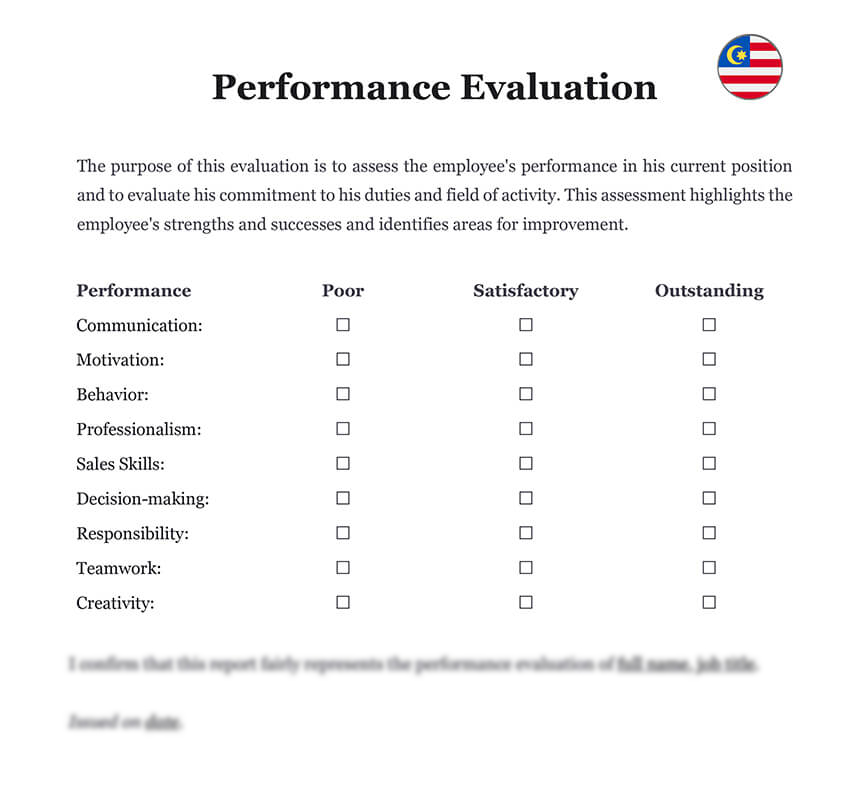Establishing performance standards to evaluate the performance of an employee
Performance standards provide a clear set of expectations for Employees and serve as a benchmark for their job performance. To establish performance standards, it is important to consider the specific responsibilities and duties of each role within the organisation. In order to evaluate the performance of an employee, companies may use job descriptions, performance metrics, and industry standards to determine what constitutes acceptable performance.
In Malaysia, KPI stands for Key Performance Indicators and is used in many organizations to measure and evaluate the performance of individuals, teams, and departments. The KPI are written in the Employment Contract and we therefore encourage you to download it.
Once established, performance standards should be communicated to all employees, and regularly reviewed and updated to ensure they are relevant and meet the changing needs of the business. Having clear and well-defined performance standards in place helps to ensure that the evaluation process is fair, consistent, and supports the professional growth and development of employees in Malaysia.
ℹ️ Writing an Employee Performance Evaluation is an important task for assessing the performance of an employee and providing constructive feedback for improvement. If the performance evaluation is not good enough, you can send your employee an Employee Warning Letter. Following this, if the employee still conducts poor performance, the employer may write an Employment Termination Letter.
Gathering data in order to evaluate the performance of an employee
| ➤ The data collected will serve as the basis for the evaluation report and provide a comprehensive picture of the employee's job performance. Companies may use a variety of sources to gather data, including sales figures, project reports, customer feedback, and any other relevant metrics. |
| ➤ It is important to ensure that the data collected is relevant, accurate, and up-to-date. |
| ➤ Additionally, companies may also seek input from colleagues, supervisors, and other relevant stakeholders to gain a well-rounded understanding of the employee's performance. |
Gathering data in a systematic and comprehensive manner helps to ensure that the evaluation process is objective and fair.
Scheduling the evaluation meeting
Scheduling an evaluation meeting for an employment performance evaluation in Malaysia requires careful consideration of a number of factors.
1. The meeting should be held at a time that is convenient for both the employee and the manager, and should take place in a private and comfortable setting to promote open and honest communication.
2. It is important to provide sufficient notice to the employee so that they have enough time to prepare and gather any relevant information or documentation.
3. It is a good idea to confirm the details of the meeting in advance, including the date, time, location, and agenda, to ensure that both parties are fully prepared.
By taking these steps, you can create a productive and positive atmosphere in order to evaluate the performance of an employee, which will help to promote a successful outcome for both the employee and the organisation.
Preparing an evaluation report
Preparing an evaluation report for an employment performance evaluation in Malaysia requires a systematic and thorough approach to documenting the employee’s performance over a specified period of time.
| ➤ The report should start by outlining the purpose and scope of the evaluation, including any relevant policies, procedures, or guidelines that apply. |
| ➤ The report should then provide a clear and concise summary of the employee's strengths, weaknesses, and areas for improvement, based on objective data and evidence gathered through various sources such as performance metrics, feedback from colleagues, and self-assessment. |
| ➤ Finally, the report should include recommendations for future performance and professional development, based on the employee's goals, needs, and strengths. |
ℹ️ By following these steps, you can produce an effective and fair evaluation report that will support the employee’s growth and development and help to achieve the organization’s goals and objectives.

Reviewing the report with the employee
This meeting provides an opportunity for the employee and manager to discuss the results of the evaluation and to address any questions or concerns that may arise. It is important to create a supportive and non-confrontational atmosphere for the meeting, and to encourage the employee to ask questions and provide feedback. During the review, the manager should take the time to discuss the employee’s strengths, weaknesses, and areas for improvement, and to provide specific, actionable suggestions for growth and development.
The employee should also be given the opportunity to provide their own perspective on their performance and to discuss any challenges or obstacles that may have impacted their performance.
ℹ️ By ensuring open and honest communication during the review, both parties can gain a better understanding of the employee’s performance and identify opportunities for improvement and growth.
Agreeing on goals and action plans
After the review of the evaluation report, the employee and manager should work together to establish clear and measurable goals that align with the employee’s strengths, needs, and career aspirations, as well as with the organization’s objectives. These goals should be specific, achievable, and time-bound, and should include action plans that outline the steps that the employee will take to achieve each goal. The action plans should be realistic and achievable, and should take into account any resources or support that may be needed.
The employee and manager should also agree on a timeline for progress reviews to ensure that the goals and action plans are on track. By setting clear and achievable goals and action plans, the employee can focus their efforts on areas of improvement and growth, and the organization can support the employee’s development and ensure that the goals and objectives are met.
Following up after the evaluation of the performance of the employee
Regular progress reviews should be conducted to monitor the employee’s progress towards their goals and to ensure that the action plans are on track. During these reviews, the manager should provide the employee with feedback on their performance and offer support and guidance as needed. The employee should also be encouraged to provide updates on their progress and to discuss any challenges or obstacles that may have arisen.
If necessary, the goals and action plans should be revised and updated to reflect changes in the employee’s performance or the organization’s needs.
By conducting regular follow-up reviews, the employee and manager can ensure that the performance evaluation remains relevant and effective, and that the employee continues to grow and develop in their role.
Documenting after having evaluated the performance of an employee
This template document serves as a record of the employee’s performance, feedback, and goals, and provides a reference for future performance evaluations and career development. The evaluation report, along with any action plans, goals, and follow-up reviews, should be securely stored in the employee’s personnel file, and should be readily accessible for review as needed
ℹ️ It is important to ensure that the documentation is accurate, objective, and fair, and that it reflects the employee’s performance and development over time.
The employee should also be provided with a copy of the evaluation report and any relevant documentation, and should be encouraged to review the information and provide any feedback or comments.
By documenting the performance evaluation, the organization can ensure that the evaluation process is transparent and consistent, and that the employee’s progress and development is accurately recorded and tracked over time.
Ask our employment law experts to help you manage your employees
310 client reviews (4.8/5) ⭐⭐⭐⭐⭐











